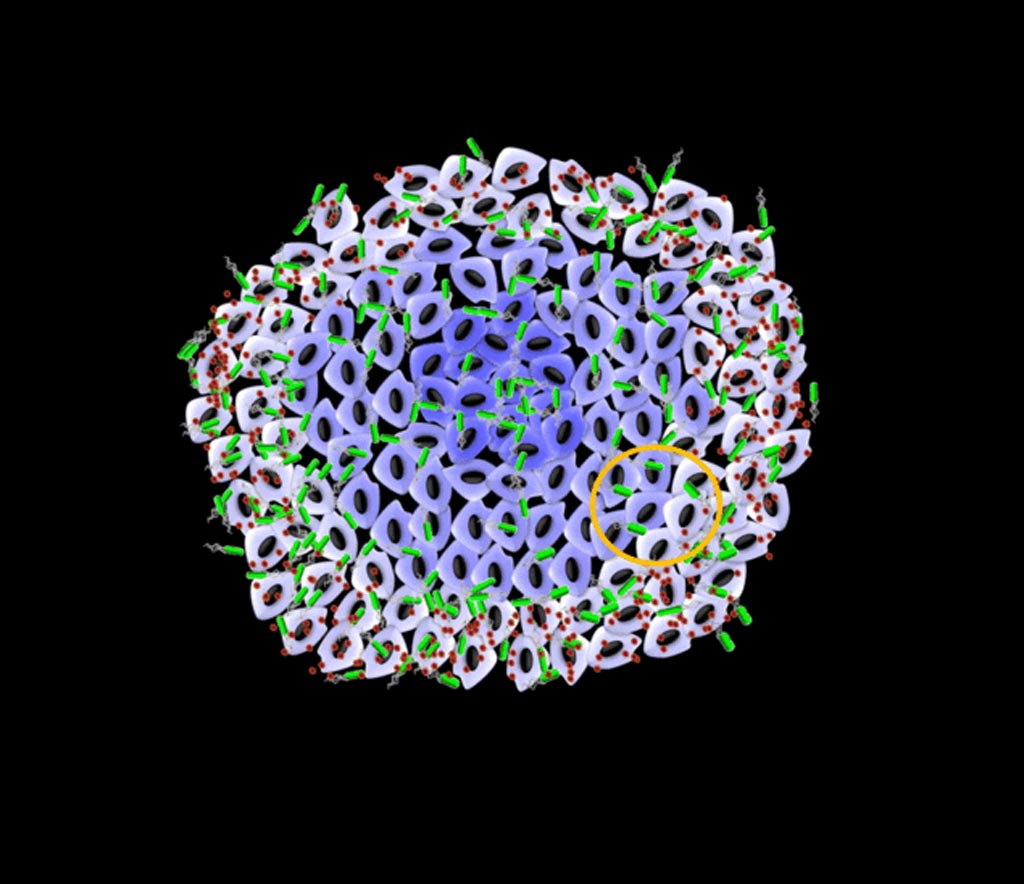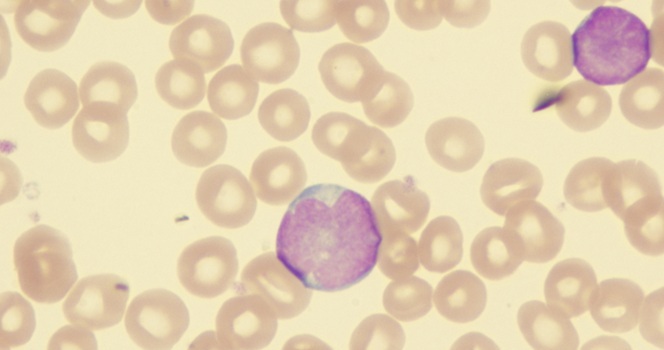Targeted System Uses Conjugated Bacteria to Deliver Drugs
|
By LabMedica International staff writers Posted on 31 Dec 2018 |

Image: NanoBEADS transporters were constructed by conjugating poly(lactic‐co‐glycolic acid) nanoparticles with tumor‐targeting Salmonella typhimurium bacteria (Photo courtesy of Virginia Tech).
A novel delivery system for anti-cancer chemotherapeutic agents utilizes attenuated bacteria that have been conjugated to polymeric nanoparticles to transport the drugs via a targeted, passive process.
Cancer drug delivery is problematic due to systemic toxicity of the drugs and inadequate movement of such nanotherapeutic agents to cells in sites distant from blood vessels. In an attempt to solve these problems, investigators at Virginia Tech (Blacksburg, VA, USA) proposed that an attenuated bacterium could be exploited for autonomous targeted delivery of nanotherapeutics to currently unreachable sites.
For this purpose, the investigators selected Salmonella enterica serovar Typhimurium VNP20009 (S. typhimurium), as it had been thoroughly studied and had been tested successfully in a phase one clinical trial. For the current study, a nanoscale bacteria‐enabled autonomous drug delivery system (NanoBEADS) was developed in which the functional capabilities of the tumor‐targeting S. typhimurium were interfaced with poly(lactic‐co‐glycolic acid) nanoparticles. Poly(lactic-co-glycolic acid) is a copolymer which is used in a host of [U.S.] Food and Drug Administration approved therapeutic devices, owing to its biodegradability and biocompatibility.
The investigators evaluated the impact of nanoparticle conjugation on the ability of NanoBEADS' to invade cancer cells. This was done by examining intratumoral transport of beads in three-dimensional tumor spheroids in vitro, and the biodistribution of the beads in a mammary tumor model in vivo. The investigators reported in the December 5, 2018, online edition of the journal Advanced Science that intercellular self‐replication and translocation were the dominant mechanisms of bacteria intratumoral penetration and that nanoparticle conjugation did not impede the bacteria's intratumoral transport performance.
The investigators further demonstrated that NanoBEADS enhanced nanoparticle retention and distribution in solid tumors by up to a remarkable 100‐fold without requiring any externally applied driving force or control input.
"You can make the most amazing drugs, but if you cannot deliver it where it needs to go, it cannot be very effective," said senior author Dr. Bahareh Behkam, associate professor of mechanical engineering at Virginia Tech. "By improving the delivery, you can enhance efficacy."
"Its (salmonella's) job as a pathogen is to penetrate through the tissue," said Dr. Behkam. "What we thought is if bacteria are so good at moving through the tissue, how about coupling nanomedicine with the bacterium to carry that medicine much farther than it would passively diffuse on its own?"
Related Links:
Virginia Tech
Cancer drug delivery is problematic due to systemic toxicity of the drugs and inadequate movement of such nanotherapeutic agents to cells in sites distant from blood vessels. In an attempt to solve these problems, investigators at Virginia Tech (Blacksburg, VA, USA) proposed that an attenuated bacterium could be exploited for autonomous targeted delivery of nanotherapeutics to currently unreachable sites.
For this purpose, the investigators selected Salmonella enterica serovar Typhimurium VNP20009 (S. typhimurium), as it had been thoroughly studied and had been tested successfully in a phase one clinical trial. For the current study, a nanoscale bacteria‐enabled autonomous drug delivery system (NanoBEADS) was developed in which the functional capabilities of the tumor‐targeting S. typhimurium were interfaced with poly(lactic‐co‐glycolic acid) nanoparticles. Poly(lactic-co-glycolic acid) is a copolymer which is used in a host of [U.S.] Food and Drug Administration approved therapeutic devices, owing to its biodegradability and biocompatibility.
The investigators evaluated the impact of nanoparticle conjugation on the ability of NanoBEADS' to invade cancer cells. This was done by examining intratumoral transport of beads in three-dimensional tumor spheroids in vitro, and the biodistribution of the beads in a mammary tumor model in vivo. The investigators reported in the December 5, 2018, online edition of the journal Advanced Science that intercellular self‐replication and translocation were the dominant mechanisms of bacteria intratumoral penetration and that nanoparticle conjugation did not impede the bacteria's intratumoral transport performance.
The investigators further demonstrated that NanoBEADS enhanced nanoparticle retention and distribution in solid tumors by up to a remarkable 100‐fold without requiring any externally applied driving force or control input.
"You can make the most amazing drugs, but if you cannot deliver it where it needs to go, it cannot be very effective," said senior author Dr. Bahareh Behkam, associate professor of mechanical engineering at Virginia Tech. "By improving the delivery, you can enhance efficacy."
"Its (salmonella's) job as a pathogen is to penetrate through the tissue," said Dr. Behkam. "What we thought is if bacteria are so good at moving through the tissue, how about coupling nanomedicine with the bacterium to carry that medicine much farther than it would passively diffuse on its own?"
Related Links:
Virginia Tech
Latest BioResearch News
- Genome Analysis Predicts Likelihood of Neurodisability in Oxygen-Deprived Newborns
- Gene Panel Predicts Disease Progession for Patients with B-cell Lymphoma
- New Method Simplifies Preparation of Tumor Genomic DNA Libraries
- New Tool Developed for Diagnosis of Chronic HBV Infection
- Panel of Genetic Loci Accurately Predicts Risk of Developing Gout
- Disrupted TGFB Signaling Linked to Increased Cancer-Related Bacteria
- Gene Fusion Protein Proposed as Prostate Cancer Biomarker
- NIV Test to Diagnose and Monitor Vascular Complications in Diabetes
- Semen Exosome MicroRNA Proves Biomarker for Prostate Cancer
- Genetic Loci Link Plasma Lipid Levels to CVD Risk
- Newly Identified Gene Network Aids in Early Diagnosis of Autism Spectrum Disorder
- Link Confirmed between Living in Poverty and Developing Diseases
- Genomic Study Identifies Kidney Disease Loci in Type I Diabetes Patients
- Liquid Biopsy More Effective for Analyzing Tumor Drug Resistance Mutations
- New Liquid Biopsy Assay Reveals Host-Pathogen Interactions
- Method Developed for Enriching Trophoblast Population in Samples
Channels
Clinical Chemistry
view channel
Chemical Imaging Probe Could Track and Treat Prostate Cancer
Prostate cancer remains a leading cause of illness and death among men, with many patients eventually developing resistance to standard hormone-blocking therapies. These drugs often lose effectiveness... Read more
Mismatch Between Two Common Kidney Function Tests Indicates Serious Health Problems
Creatinine has long been the standard for measuring kidney filtration, while cystatin C — a protein produced by all human cells — has been recommended as a complementary marker because it is influenced... Read moreMolecular Diagnostics
view channel
New Blood Biomarkers Help Diagnose Pregnancy-Linked Liver Complication
Intrahepatic cholestasis of pregnancy (ICP) is the most common liver disorder linked to pregnancy and can pose serious risks for both mother and baby, including premature delivery and stillbirth.... Read more
Simple Urine Test to Revolutionize Bladder Cancer Diagnosis and Treatment
Bladder cancer is one of the most common and deadly urological cancers and is marked by a high rate of recurrence. Diagnosis and follow-up still rely heavily on invasive cystoscopy or urine cytology, which... Read moreHematology
view channel
MRD Tests Could Predict Survival in Leukemia Patients
Acute myeloid leukemia is an aggressive blood cancer that disrupts normal blood cell production and often relapses even after intensive treatment. Clinicians currently lack early, reliable markers to predict... Read more
Platelet Activity Blood Test in Middle Age Could Identify Early Alzheimer’s Risk
Early detection of Alzheimer’s disease remains one of the biggest unmet needs in neurology, particularly because the biological changes underlying the disorder begin decades before memory symptoms appear.... Read more
Microvesicles Measurement Could Detect Vascular Injury in Sickle Cell Disease Patients
Assessing disease severity in sickle cell disease (SCD) remains challenging, especially when trying to predict hemolysis, vascular injury, and risk of complications such as vaso-occlusive crises.... Read more
ADLM’s New Coagulation Testing Guidance to Improve Care for Patients on Blood Thinners
Direct oral anticoagulants (DOACs) are one of the most common types of blood thinners. Patients take them to prevent a host of complications that could arise from blood clotting, including stroke, deep... Read moreImmunology
view channel
New Test Distinguishes Vaccine-Induced False Positives from Active HIV Infection
Since HIV was identified in 1983, more than 91 million people have contracted the virus, and over 44 million have died from related causes. Today, nearly 40 million individuals worldwide live with HIV-1,... Read more
Gene Signature Test Predicts Response to Key Breast Cancer Treatment
DK4/6 inhibitors paired with hormone therapy have become a cornerstone treatment for advanced HR+/HER2– breast cancer, slowing tumor growth by blocking key proteins that drive cell division.... Read more
Chip Captures Cancer Cells from Blood to Help Select Right Breast Cancer Treatment
Ductal carcinoma in situ (DCIS) accounts for about a quarter of all breast cancer cases and generally carries a good prognosis. This non-invasive form of the disease may or may not become life-threatening.... Read moreMicrobiology
view channel
Rapid Diagnostic Test Matches Gold Standard for Sepsis Detection
Sepsis kills 11 million people worldwide every year and generates massive healthcare costs. In the USA and Europe alone, sepsis accounts for USD 100 billion in annual hospitalization expenses.... Read moreRapid POC Tuberculosis Test Provides Results Within 15 Minutes
Tuberculosis remains one of the world’s deadliest infectious diseases, and reducing new cases depends on identifying individuals with latent infection before it progresses. Current diagnostic tools often... Read more
Rapid Assay Identifies Bloodstream Infection Pathogens Directly from Patient Samples
Bloodstream infections in sepsis progress quickly and demand rapid, precise diagnosis. Current blood-culture methods often take one to five days to identify the pathogen, leaving clinicians to treat blindly... Read morePathology
view channel
Rapid Low-Cost Tests Can Prevent Child Deaths from Contaminated Medicinal Syrups
Medicinal syrups contaminated with toxic chemicals have caused the deaths of hundreds of children worldwide, exposing a critical gap in how these products are tested before reaching patients.... Read more
Tumor Signals in Saliva and Blood Enable Non-Invasive Monitoring of Head and Neck Cancer
Head and neck cancers are among the most aggressive malignancies worldwide, with nearly 900,000 new cases diagnosed each year. Monitoring these cancers for recurrence or relapse typically relies on tissue... Read more
Common Health Issues Can Influence New Blood Tests for Alzheimer’s Disease
Blood-based tests for Alzheimer’s disease are transforming diagnosis by offering a simpler alternative to spinal taps and brain imaging. However, many people evaluated at memory clinics also live with... Read more
Blood Test Formula Identifies Chronic Liver Disease Patients with Higher Cancer Risk
Chronic liver disease affects millions worldwide and can progress silently to hepatocellular carcinoma (HCC), one of the deadliest cancers globally. While surveillance guidelines exist for patients with... Read moreTechnology
view channel
Artificial Intelligence Model Could Accelerate Rare Disease Diagnosis
Identifying which genetic variants actually cause disease remains one of the biggest challenges in genomic medicine. Each person carries tens of thousands of DNA changes, yet only a few meaningfully alter... Read more
AI Saliva Sensor Enables Early Detection of Head and Neck Cancer
Early detection of head and neck cancer remains difficult because the disease produces few or no symptoms in its earliest stages, and lesions often lie deep within the head or neck, where biopsy or endoscopy... Read moreIndustry
view channel
Abbott Acquires Cancer-Screening Company Exact Sciences
Abbott (Abbott Park, IL, USA) has entered into a definitive agreement to acquire Exact Sciences (Madison, WI, USA), enabling it to enter and lead in fast-growing cancer diagnostics segments.... Read more





















